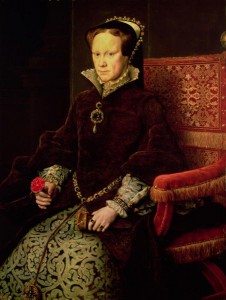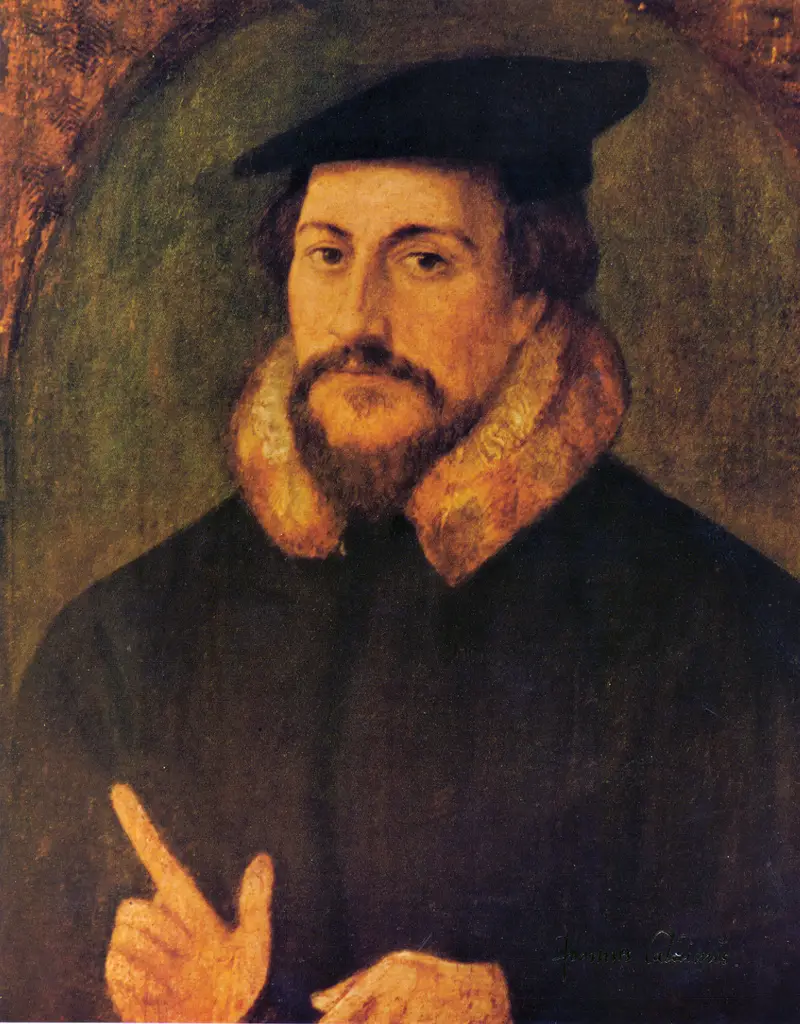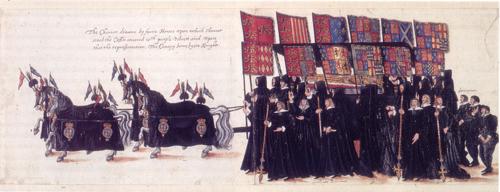You can read a full transcript of Mary I's will at http://tudorhistory.org/ or in the appendix of J. M. Stone's 1901 book The History of Mary I, Queen of England. The original document, Harleian MS 6949, f. 29, no longer exists.
Here are the key points of Mary's will:
- That her mother Catherine of Aragon's remains be moved from Peterborough and buried with Mary and Mary's "Executors to cawse to be made honorable tombs or monuments for a decent memory of us."
- Provision for alms for the poor and needy and provision for the religious houses of Sheen and Sion which Mary re-established in her reign following their dissolution in her father's reign. She asks for those houses to pray for her soul and those of her husband, mother, father and "all other our Progenitours". Mary also leaves money to the Observant Friars of Greenwich, the Black Friars at St Bartholomews, and various other orders and establishments with requests for them to say "dayly Masses, Suffrages, and Prayers".
- Provision for the "pore Scolers" of the Universities of Oxford and Cambridge, particularly those intending to go into the Church.
- Provision for the Hospital of Savoy, which was established by her grandfather, Henry VII.
- A request that her executors "provide some convenient howse within or nye the Suburbs of the Citie of London" as a hospital for those injured in wars fighting for the kingdom and to provide relief for "pore, impotent and aged Soldiers".
- That her executors should pay off her debts and any still owed by her father, Henry VIII, and her brother, Edward VI.
- The restoration of lands formerly belonging to the Church and taken during the Dissolution.
- A request for Cardinal Reginald Pole to finish his "good work in this Realme" and for her executors, council and subjects to help him in this.
- Provision for her servants and special provisions for named servants, e.g. Dr Malet, her almoner and confessor, and provisions for named churchmen.
- That her crowns, titles, honours, lands, jewels, ships etc. go to her heir, the fruit of her body, and that her husband, Philip should act as regent during the minority of her heir.
- For her subjects to show her husband the same duty and love they showed her.
- A warning for her executors to follow the terms of her will because they would be answerable to God at Judgement Day.
- A request for "most dere beloved Lord and husband the King's Majesty" to "take upon hym the pryncipall and the chefest care of thexecutyon" of her will and to act as a patron to the other executors.
- A request for her husband "to kepe for a memory of me" the table diamond that his father, Charles V, had sent to her, along with another table diamond, a collar of gold set with nine diamonds and a ruby ring. Mary stated that Philip could do what he wanted with these pieces and could pass them on to their issue.
- A request for Cardinal Pole to be one of her executors with a provision of £1000 for him doing so.
- Provisions for the other executors, who included, the Archbishop of York, and various other churchmen and nobles. Some to be paid £500 and others 500 marks.
- Provision for named "righte well beloved Servants and Councellors" who would act as assistants to the executors.
This will was witnessed by Henry Bedingfield, Thomas Wharton, John Throckmorton and R. Wilbrahm, and signed and sealed by Mary.
Mary never did give birth, she wasn't actually pregnant, but she did die that year, on 17th November 1558, with Cardinal Pole dying on the same day. It was Mary's Protestant half-sister Elizabeth I who inherited the throne.




I always feel sorry for Mary, she so wanted to return England to the time of her youth. England had changed but sadly she hadn’t and couldn’t understand why the people would not accept the Pope as head of the Church once again. In short Henry had set them free from Papal slavery.
The majority of people in England were still Catholic. The majority of people actually wanted to remain traditionally Catholic. The Catholic Church did not enslave people.
There was no such thing a papal slavery. Much of the country outside of London & far from the seat of government clung to the old faith, although they had protestantism imposed on them. Obviously there was a generation which knew nothing of the old faith.
Papal slavery might be a bit harsh. Henry created a much more literal slavery by his Oath of Supremacy.
Papal slavery might be a bit harsh. Rome could only try to influence people. ..she had no arm to force compliance. Henry created a much more literal slavery by his Oath of Supremacy. All of Reformation history is a study of leaders trying to force their religious preferences on their subjects. Letting people follow their own consciences doesn’t fit in with the Divine Right of Kings.
Here, here, plus the Act of Uniformity didn’t leave much room for freedom. Did monarchy even understand the concept of freedom to practice ones religious beliefs as you please? Even pretty speeches about not making windows into mens souls turned out to be nonsense as Elizabeth was opposed by Parliament and a Council who ensured that anti Catholic and anti Puritan legislation were passed as part of their idea of unity in England. In fact the Reformation destroyed Christian unity in Europe, period. Nobody lived in slavery by the Church, you were able to think freely, nobody forced you to be a heretic, that’s a choice.
Glad Katherine of Aragon was left resting in peace at Peterborough as she was honoured here. She has her own festival each year and it was a privilege to see her burial place a few years ago. It’s actually nice to think that Westminster dosent have all of our Kings and Queens or other royal and noble people, that the joy of visiting them is spread around and not restricted to Westminster, where it costs at least £17.00 to go in and they are open very restrictive hours…till 1.30 on a Saturday for example. I felt at home at Katherine’s tomb, much more than when visiting the Abbey. I can understand Mary’s wish….but I feel now it’s turned out better.
No repentance for burning 300 people to death? Why am I not surprised? Put me,in the “no sympathy for Mary, bring on Elizabeth!” group.
I’m not sure that Elizabeth “repented” for her actions towards the Catholics either, or that their father “repented” for his actions towards Catholics and Reformers. Not to condone their actions, but these kings and queens would have believed that they were doing the right thing for their people and themselves.
Good points.
Mary didn’t burn anyone, 286 were condemned, mostly by local magistrates, with some high profile legally condemned, but Mary only had any involvement in the latter, not the parish, community trials and executions. She like any other Monarch had a duty to allow the hersey laws to stand.
Elizabeth gradually consented to harsher laws against Catholics which she believed were traitors for many different reasons, paranoid, she thought they were involved in plots and political reasons. Crippling fines, imprisonment, death, all contributed to this persecution but she also believed she was doing right. Monarchs don’t tend to act in a way we can understand now, because they thought they were divinely appointed.
Besides how do people know if they repented or not? We don’t know what they were thinking. They made peace with God and their enemies and asked forgiveness of their sins. Mary had a more tranquil death than Elizabeth, that is all we know.
Those innocent men women and children ( let’s not forget children) were burned at the stake because Mary commanded it. It’s sophistry to say that she was not ultimately responsible.
Quite correct Parliament had re-enacted the heresy laws and she was advised by her council. Unlike today with speedy travel and communication Mary could not closely monitor what her officials did far from London.
There were many many horrible executions under Elizabeth I, one such was (Saint) Margaret Clitherow who was stripped naked and crushed to death under her front door, Margaret it was said was pregnant with her fourth child at the time. I read somewhere that the Queen (Elizabeth) was appalled and wrote to the officals in York.
What does that mean?
I think it means “our queen”.
I’ve always felt so sad for Queen Mary I. Such a traumatic childhood. To go from your Father’s beloved to disowned, to see her Mother, a born, true Princess of blood and the Queen England loved, just cast aside and forgotten all while forbidden from seeing her. Then for your legacy to be remembered as ‘Bloody Mary,’ it’s just so sad and sickening. She was a happy child, a sad teen, a confused young adult, and a Queen stuck in the far past. And on top of all of that, everything she did as Queen and all the changes and provisions she made were all undone by her sister and next Queen, Elizabeth I. She’s better remembered for being the Daughter of Catherine of Aragon than she is for being Queen of England.
Yes, a very traumatic childhood. At one point, Eustace Chapuys, the imperial ambassador, feared for her life and it was he who persuaded her to submit to her father and sign the oath accepting her illegitimate status and the annulment of her parents’ marriage. That must have been such a sacrifice for her and must have played on her mind. It is little wonder that she suffered from ill health. If only Henry VIII had found her a husband early on, I’m sure that would have helped her.
Mary’s will was very detailed and shows really who she was, her concerns and her provisions for what she saw as continuing to be a Catholic country, which it would have been with her child, had Mary given birth. However, she had cancer instead and was never going to have children, so her dream ended.
She thinks of the poor and the religious houses and Friars and their schools for poor scholars.
She thinks of her mother, moving her body in accordance with her Royal dignity and moved to lay with her in Westminster Abbey.
She cared about her servants and the memory of the members of her family, her mother and father and grandfather and she prepares for a temporary Regency under Philip for her unborn child and she gives many endowments to hospitals and the religious orders.
She leaves money and wishes for her soul and she leaves money for her servants and her executors, all quite normal.
She makes provision for the future and the good of the realm.
Mary should be remembered for far more than the religious persecution of her reign, regardless of how horrible it was, because she was so much more. She was fervent in her belief, it is true, but this was the same belief as the majority of her people and she had a duty to them, but she also showed much mercy and wisdom in her reign, something often forgotten. Mary released hundreds of rebels in one day and forgave hundreds more. 400, condemned to death she personally saved. She was genuinely pro active in her faith which was not old and Medieval but a much more evangelical and charismatic and she kept many of her father’s early reforms which were not destructive. She restored the Church to former beauty and she restored many shrines. She built hospitals and schools and restored the economy and trade abroad. She offered a period of grace and a long preaching and educational campaign before her government passed the revised heresy laws, which led to the horrible deaths of many people, but horrific as it was, this was a normal part of the war against heresy as it was deemed dangerous. Elizabeth I saw Catholics as traitors and they were also killed in a horrible manner. Monarchs saw themselves as the instrument of the Lord and the Supremacy gave them too much power. We can never condone the death penalty for people standing up for their faith, because the monarchy had a different one, it was of course for us wrong, but that isn’t the thing for 500 years ago, they had a duty to unite their people in one faith, their methods for doing that were sometimes ruthless and cruel, sometimes they used better methods, they gave people time to recant, but at the end of the day, you had to make a choice.
Mary also achieved much in making the gender neutral concept of the crown acceptable and Elizabeth would not have reigned had it not been for Mary taking back control from Jane Grey and her supporters or winning over support v Thomas Wyatt the Younger. Had Mary had children her legacy would be viewed in a much less biased way now and she was aware of how dangerous the task of childbirth was. That is why she wrote this very detailed will. This isn’t the mind of a woman blinded by cruelty but a woman who cares for her people and their salvation as well as those around her. Unlike Elizabeth, at least Mary cared what happened to the soldiers injured in her war or in putting down revolts. She put aside provision for them and made sure they had hospitals and homes to be cared for in her will.
He had limited powers of direct control, so successful Lord Lieutenants worked with his deputy lieutenants and dealt with the gentry through compromise, consensus, and the inclusion of opposing factions. He was in charge of mobilising the militia if necessary for defence, or to assist the king in military operations. In Yorkshire in 1588, the Lord Lieutenant was the Earl of Huntington, who urgently needed to prepare defences in the face of the threatened invasion from the Spanish Armada. The Queen’s Privy Council urgently called upon him to mobilise the militia, and report on the availability of men and horses. Huntington’s challenge was to overcome the reluctance of many militia men, the shortages of arms, training mishaps, and jealousy among the gentry as to who would command which unit. Despite Huntingdon’s last-minute efforts, the mobilisation of 1588 revealed a reluctant society that only grudgingly answered the call to arms. The Armada never landed, and the militia were not actually used.